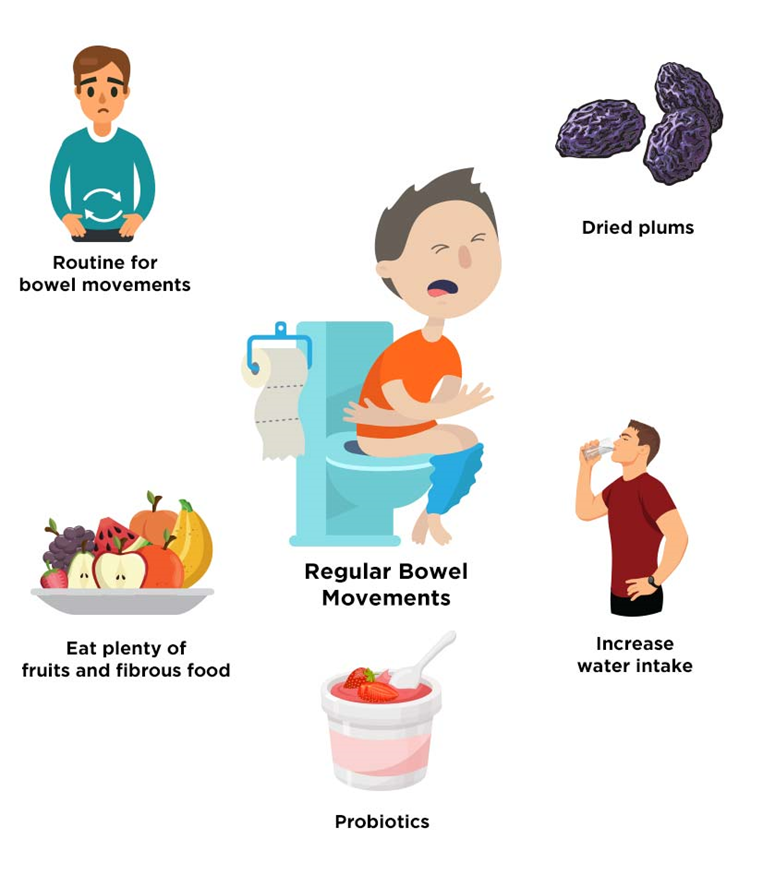A nurse is providing teaching to a postoperative client regarding diet. Which nutrient is responsible for maintaining healthy bowel elimination?
Fiber
Fat
Protein
Minerals
The Correct Answer is A
Choice A Reason:
Fiber is correct. Fiber is essential for maintaining healthy bowel elimination. It helps to add bulk to the stool and promotes regular bowel movements. There are two types of fiber: soluble and insoluble. Soluble fiber absorbs water and forms a gel-like substance, which helps soften the stool and make it easier to pass. Insoluble fiber adds bulk to the stool and helps it move through the digestive tract more quickly.

Choice B Reason:
Fat is incorrect. While fats are an important part of a balanced diet, they do not play a primary role in maintaining healthy bowel elimination. Fats are essential for energy and the absorption of fat-soluble vitamins, but they do not have the same effect on bowel movements as fiber.
Choice C Reason:
Protein is incorrect. Protein is crucial for building and repairing tissues, but it does not directly influence bowel elimination. A diet high in protein without adequate fiber can sometimes lead to constipation.
Choice D Reason:
Minerals are incorrect. Minerals are vital for various bodily functions, including bone health, fluid balance, and muscle function. However, they do not directly impact bowel elimination in the same way that fiber does.
Nursing Test Bank
Naxlex Comprehensive Predictor Exams
Related Questions
Correct Answer is C
Explanation
Choice A Reason:
Open the client’s visual acuity using a Snellen chart is incorrect. This action assesses cranial nerve II (optic nerve), which is responsible for vision. The Snellen chart is used to measure visual acuity, not the function of cranial nerve VI
Choice B Reason:
Whisper none of the client’s ears while blocking the other is incorrect. This action assesses cranial nerve VIII (vestibulocochlear nerve), which is responsible for hearing and balance. Whispering tests the auditory function of this nerve.
Choice C Reason:
Ask the client to inspect up is correct. Cranial nerve VI (abducens nerve) controls the lateral rectus muscle, which is responsible for moving the eye outward. Asking the client to look up and outward helps assess the function of this nerve.
Choice D Reason:
Ask the client to smile is incorrect. This action assesses cranial nerve VII (facial nerve), which controls the muscles of facial expression. Smiling tests the motor function of this nerve.
Correct Answer is A
Explanation
Choice A Reason:
Use good body mechanics is correct. Good body mechanics involve using the body in an efficient and careful way to prevent injury. This includes bending at the knees instead of the waist, keeping the back straight, and using the legs to lift heavy objects. Proper body mechanics reduce the strain on the back and joints, preventing injuries.
Choice B Reason:
Maintain proper posture is also important but is part of using good body mechanics. Proper posture involves keeping the spine in a neutral position, avoiding slouching, and ensuring that the head is aligned with the spine. This helps distribute weight evenly and reduces the risk of injury.
Choice C Reason:
Use assistive devices is correct. Assistive devices such as transfer boards, mechanical lifts, and gait belts can help reduce the physical strain on nurses when moving or lifting patients. These devices are designed to make tasks safer and easier, thereby minimizing the risk of back and joint injuries.
Choice D Reason:
Stay physically fit is also important. Physical fitness helps maintain muscle strength, flexibility, and endurance, which are crucial for performing physically demanding tasks. Regular exercise can help prevent injuries by improving overall body mechanics and reducing fatigue.
Whether you are a student looking to ace your exams or a practicing nurse seeking to enhance your expertise , our nursing education contents will empower you with the confidence and competence to make a difference in the lives of patients and become a respected leader in the healthcare field.
Visit Naxlex, invest in your future and unlock endless possibilities with our unparalleled nursing education contents today
Report Wrong Answer on the Current Question
Do you disagree with the answer? If yes, what is your expected answer? Explain.
Kindly be descriptive with the issue you are facing.
